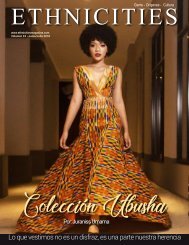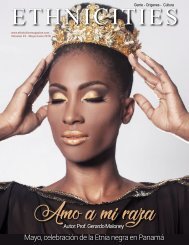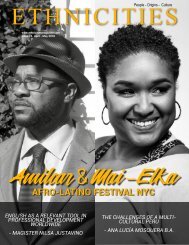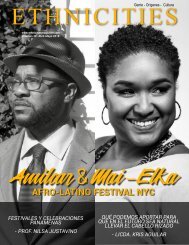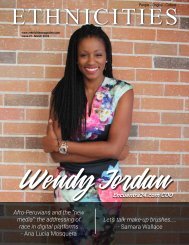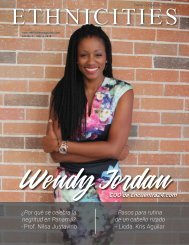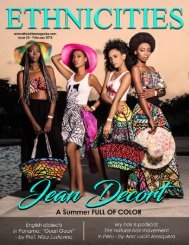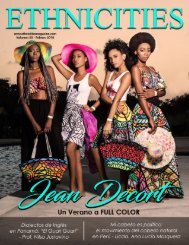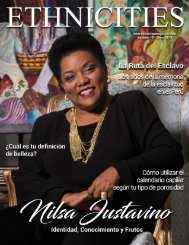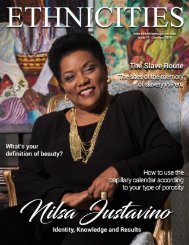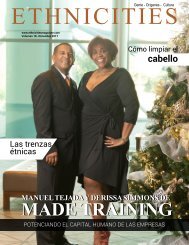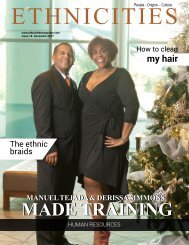Ethnicities Magazine_Mayo-june 2018_Issue_23_Ingles
You also want an ePaper? Increase the reach of your titles
YUMPU automatically turns print PDFs into web optimized ePapers that Google loves.
People - Origins - Culture<br />
ETHNICITIES<br />
www.ethnicitiesmagazine.com<br />
<strong>Issue</strong> <strong>23</strong> - May/June <strong>2018</strong><br />
Amo a mi raza<br />
Author: Prof. Gerardo Maloney<br />
May, Black Ethnicity Celebration in Panama
¡tú anuncio puede<br />
estar aquí!<br />
Para mayor información<br />
contáctenos a:<br />
info@ethnicitiesmagazine.com<br />
www.ethnicitiesmagazine.com<br />
Síguenos en:
CONTENT<br />
ETHNICITIES<br />
Editorial Letter<br />
Licda. Keila Salazar de Moreno<br />
Tewali Bung..........................................................................3<br />
Magister, Nilsa Justavino<br />
Redefining Afropanamanian dress..............................4<br />
Ninna Marie Ottey, B.A.<br />
The Afro-Peruvian popultation in the media..........13<br />
Ana Lucía Mosquera, B.A.<br />
Fashion Trends - Amo a mi raza................................15<br />
Poem by Gerardo Maloney<br />
Wake up and Make up....................................................21<br />
Samara Wallace, B.A.<br />
Transformation, the route to be a beautiful path..24<br />
Jessica Bernard, B.A.<br />
Socials.................................................................26<br />
24<br />
4<br />
AFROPANAMANIAN DRESS<br />
TRANSFORMATION, THE ROUTE TO<br />
BE A BEAUTIFUL PATH<br />
FOUNDER & EDITOR IN CHIEF<br />
Keila Salazar de Moreno, B.A.<br />
info@ethnicitiesmagazine.com<br />
GRAPHIC DESIGN<br />
Stephany Salazar, B.A.<br />
stephany.salazar20@gmail.com<br />
PHOTOGRAPHS<br />
www.pixbay.com<br />
Vina Yetman<br />
COVER CONTENT PHOTOGRAPHS<br />
Cover photo y Fashion TRENDS:<br />
Production: Vina Yetman<br />
Photograph: Vina Yetman<br />
Crown & details: LadyLu Vintage Store<br />
Make up: Dérika Bulgin de My Makeup PTY<br />
Dressing: Garbo by Greta<br />
SALES, MAERKETING AND PUBLIC<br />
RELATIONS<br />
Keila Salazar de Moreno, B.A.<br />
MAY - JUNE WRITERS<br />
Magister, Nilsa Justavino<br />
Ana Lucía Mosquera, B.A.<br />
Kris Aguilar, B.A.<br />
Samara Wallace, B.A.<br />
Jessica Bernard, B.A.<br />
Nina Ottey, B.A.<br />
Cecilia Moreno, B.A.<br />
Dr. Alberto Barrow<br />
Keila Salazar de Moreno, B.A.<br />
SPANISH VERSION CORRECTION<br />
Keila Salazar de Moreno, B.A.<br />
Stephany Salazar, B.A.<br />
EDITORIAL LETTER<br />
My heart is full of happiness, and this is due to see all entrepreneurs who<br />
are in our Afro Descendant community in Panama, also to see the different<br />
private schools, public and private institutions that have joined us in<br />
the celebration of May 30th, official date of Black Ethnicity in Panama,<br />
and that all Afro Panamanians celebrate for a whole month.<br />
I mean loudly, VIVA NENGRES, I’m black and I’m proud of it. If were to be<br />
born again and had the option to choose my race, I would not hesitate for<br />
a second to choose to be black.<br />
I hope enjoy the exquisite content we bring to you this month.<br />
My special thanks to Vina Yetman the cover photograph and for Fashion<br />
Trends, Garbo by Greta who dressed our beautiful cover model Melida<br />
Asprilla from Colon, who participated for Miss Colon year <strong>2018</strong> and LadyLu<br />
Vintage Store creators of crowns of flowers and precious stones and<br />
headpieces.<br />
Thanks also to all our columnists, that every month, make possible that<br />
the content of <strong>Ethnicities</strong> <strong>Magazine</strong> is rich every month.<br />
WEBMASTER<br />
Keila Salazar de Moreno, B.A.<br />
15<br />
www.ethnicitiesmagazine.com<br />
CONTACT<br />
+507 625<strong>23</strong>175<br />
Keila Salazar de Moreno<br />
Founder & Editor in Chief<br />
<strong>Ethnicities</strong> <strong>Magazine</strong><br />
**<strong>Ethnicities</strong> <strong>Magazine</strong> investigates the seriousness of their advertisers,<br />
but i not responsible with related offers they do. The<br />
opinions expressed by the authors do not necessarily reflect the<br />
position of editor of the publication, total or partial reproduction<br />
of the content and images of the publication without prior authorization<br />
of <strong>Ethnicities</strong> <strong>Magazine</strong> is strictly prohibited.<br />
AMO A MI RAZA<br />
1 2
ETHNICITIES<br />
ETHNICITIES<br />
AFRO PANAMANIANS<br />
Author:Ephraim Alphonse, 1939<br />
TEWALI BUNG<br />
A STORY TOLD IN BOCAS CREOLE ENGLISH<br />
BY: MAGISTER, NILSA JUSTAVINO DE LOPEZ<br />
Wans apan a taim, long, long taim, wan uold<br />
man liv in a kiev. Him beard long, him foot<br />
switchy, him fingernails same like spider<br />
foot an` him eye just like puss eye. Him toe<br />
nails same like crab claw, him teet dem look<br />
like big dog tusk, an him could run so fas`not<br />
a boy nor a gal ever get `way fram him. But<br />
fi him eye can`(t) see durin`de day. Him can<br />
ongly see durin`de night.<br />
So all dem bway and gal like fe go<br />
look `pon him and tease him in a de day time.<br />
Old Rumpliss use to tell im little fas`pickney,<br />
“Don`go tease Tewali Bung. De road lang. If<br />
night ever ketch you, Tewali Bung goin`make<br />
de night so dark you won`fin`you way home”.<br />
“Lord, Pa dem tell me sé, all we fe do is carry<br />
a box a egg, an every time im t`row cowdung<br />
and make night come, me wi`take a a<br />
egg an`t`rwo it an`sun wi`shine.”<br />
“Disabedient pickney always suffer.”<br />
“Disabediant what! Me wi` beat<br />
Tewali Bung.”<br />
So Susy gan fe laugh after Tewali Bung.<br />
Tewali Bung mek dem laugh and enjay demselves<br />
till it was getting`late. Then Tewali<br />
Bung jump up quick an`took a cow dung ball<br />
and two it after dem. All a dem begin fe run.<br />
Dem run, dem run, til dem tired. Den Tewali<br />
Bung grumble and begin fe sing.<br />
hear him:<br />
“Jang ma jerry<br />
Gad amighty, pickney yeye water so sweet<br />
Whe you tink a whole a bady?<br />
Susy cried out, “Lawd pupa, a should a hear<br />
you.”<br />
Tewali Bung trow another cow-dung ball.<br />
Night come on again and Tewali Bung run,<br />
and run dem down. When Tewali get close,<br />
Susy trow another egg and daylight stop<br />
Tewali just wen him going hol Susy. Him<br />
couldn move. You see, Tewali can walk in<br />
a daylight either. Him have fe walk a night.<br />
Den Tewali trow him cow-dung ball and grab<br />
after Susy, but Susy bawl fi-she pupa, for she<br />
da get close home and Susy pupa trown egg<br />
an grab Susy, so Susy get way from Tewali<br />
Bung. Dats fe why pickney musnt be disabediant.<br />
Disabediant children wi always get in trabl.<br />
REDEFINING AFROPANAMANIAN<br />
DRESS<br />
BY: NINNA OTTEY<br />
notteymc@gmail.com<br />
Him run down Susy and grab after she. Susy<br />
eye water de run so fas she fargat de eggdem,<br />
she pupa give she fe trow. When she<br />
`member de egg-dem, she trow one egg.<br />
Daylight come back. Tewali jus`gong hol`-<br />
Susy but only she eye water him taste. Den<br />
3 4
FASHION<br />
ETHNICITIES<br />
Celebrating The Black Ethnicity month during<br />
in Panama has become increasingly distinctive<br />
in our country. Each day, there is an event<br />
to attend, a forum where can share our experiences<br />
as Afro-descendants or simply celebrate<br />
the contributions of our ancestors.<br />
There’s always someone asking for codfish<br />
fritters, for music from the Beachers at parties<br />
or asking to listen to the resonance of a<br />
Congo drum, but celebrating the month of our<br />
culture also means wearing the right attire<br />
with pride and respect.<br />
The search of the African fabrics are increasingly<br />
in the textile stores and popular streets<br />
of Panama City. There is no mother who hurriedly<br />
searches for or a good suit or dress for<br />
the events of their children’s schools during<br />
the Black Ethnicity Month.<br />
Canal’s construction and the influence of<br />
Black Power and Black is Beautiful of the African-American<br />
culture; They make our culture<br />
a true melting pot.<br />
The clothing does not escape from it.<br />
Below is shown a series of explanations about<br />
the different fabrics and clothing that you can<br />
use during this month and represent our cultural<br />
legacy with respect.<br />
ETHNICITIES<br />
How do I get dress my son/daughter? What<br />
are the typical attires of African culture or the<br />
African diaspora?<br />
These are some of the questions I have heard<br />
every single year from people who have no<br />
idea how to represent our culture. The society<br />
has forgotten to instruct our people about negritude<br />
that, it is not surprising to find people<br />
who sell fabrics or dresses with animal prints<br />
as “black costumes for the Black Ethnicity<br />
Month”.<br />
Among the rich and varied expressions that<br />
our African heritage has the language of the<br />
fabrics and the different types of clothing is<br />
one of the representatives symbology of the<br />
culture. Each attire is loaded with historical<br />
messages that are transmitted from generation<br />
to generation.<br />
Today we, the afro-descendants, use this clothings<br />
as a symbol of resistance and reaffirmation<br />
of our negritude. In Panama we are<br />
fortunate to have an incredible diversity of<br />
traditional clothing that represents the pride<br />
we have for this heritage.<br />
The mere fact of being a country where all<br />
kinds of currents are mixed: from the descendants<br />
of slaves during the colonial period,<br />
the arrival of the Antilleans for the Panama<br />
Afrocolonial Attire:<br />
One of the best known afro costumes in Panama<br />
are those of the Congo culture. It is said<br />
that they came from Central Africa to the isthmus<br />
and formed 70% of the population in the<br />
Isthmus of Panama. The black Maroons, who<br />
lived in areas further away from the larger<br />
towns, managed to preserve their ancestral<br />
customs. Among them was the population we<br />
call congos, given the name due to the great<br />
origin of black slaves arrived in Panama from<br />
the Bantu ethnic group of the Congo.<br />
Congo Women’s Clothing<br />
It consists of a shirt that can be white with<br />
long sleeves or three-quarters sleeves to represent<br />
women of high rank, or a simply pylon<br />
style with several pieces of cloth. The pollerón<br />
must be of one to three stretches of patterned<br />
or smooth fabrics and must reach the head<br />
with the arms extended. The accessories are<br />
varied: up of seven necklaces, large earrings<br />
equal or uneven, bracelets and several rings.<br />
Congo Men’s Clothing<br />
The men use their clothes upside down and<br />
old, coconut straw hats adorned with feathers,<br />
shells, mirrors or basins, and paint their faces<br />
with charcoal as a symbol of rebellion. The<br />
king or Juan de Dios wears a smaller crown<br />
than the queen’s. The strings and strips allude<br />
to the chains of slavery. The dress is complemented<br />
by a conical hat and cane, giving a<br />
parodic effect.<br />
Another of the typical costumes that represent<br />
the Afro-colonial culture the Cachimba<br />
Portobeleña. Although it is almost unknown,<br />
it was widely used in the mid 1800s and during<br />
the beginning of our republican era. This<br />
clothing was used by the black population of<br />
purchasing power, social status and academics.<br />
In this typical costume we can already notice<br />
the influence and arrival of Afro-Antilleans in<br />
the country.<br />
Antilles’ Influence<br />
The first migratory wave of Afro-Antilleans<br />
to the country was in 1844 during the construction<br />
of the railroad in Panama. They came<br />
from countries such as: Trinidad, Jamaica,<br />
Barbados, Guadeloupe or Martinique. Most<br />
of them stayed in Panama in the province of<br />
Colón and others moved to Bocas del Toro to<br />
work on banana cultivation. The next wave<br />
was in 1880 for the construction of the Panama<br />
Canal since the hands of the French<br />
5 6
FASHION<br />
ETHNICITIES<br />
company.<br />
The workmanship in this mega architectural<br />
structure is one of the greatest legacies that<br />
our Afro-Antillean ancestors could have left<br />
us, but they also brought their typical Caribbean<br />
costumes to our country:<br />
Quadrille Dress and Madras<br />
This is the name given to the traditional<br />
feminine costume of the Caribbean countries,<br />
specifically Jamaica, Trinidad, Dominica<br />
and Haiti. The suit consists of a<br />
three-quarter sleeve white shirt, usually a<br />
skirt with a plaid fabric called Madras of<br />
Indian origin brought by the English to the<br />
Caribbean. Among the accessories, they<br />
use a headwrap of the same fabric.<br />
ETHNICITIES<br />
ETHNICITIES<br />
Pollera Bocatoreña<br />
In the traditional dress of the province we<br />
can notice the strong influence of the Caribbean<br />
not only in the clothing, but in its<br />
gastronomic representation within the attire.<br />
Consists of a flower skirt with an apron,<br />
a white shirt and a headwrap to match the<br />
skirt. It is used for dances with calypso and<br />
for Palo de <strong>Mayo</strong> dance.<br />
Caribbean Dandy<br />
Gentlemen wears white shirts, black dress<br />
pants with suspenders and a beret, revisiting<br />
the traditional clothing of western Europe,<br />
specifically the English and French.<br />
Influence of West Africa<br />
Most of the Afro-Antilles who moved to<br />
Bocas del Toro during 1880 are of Ashanti-Fante<br />
origin. Thanks to them, many of<br />
the traditions of West Africa that were lost<br />
during the colonial era were recovered.<br />
As I mentioned earlier, the majority of Maroon<br />
blacks in Panama came from central<br />
Africa (Congo and Cameroon). However,<br />
it has been discovered by several anthropological<br />
studies that enslaved people<br />
from Western Africa also arrived: Angola,<br />
Guinea, Ghana, Cote d’Ivoire, Gambia and<br />
Senegal. Many of these data were lost during<br />
the colonial period because of the little<br />
interest of the Spaniards in maintaining<br />
a migratory record of the different African<br />
ethnic groups.<br />
For this and other reasons, Afro-descendants<br />
also honor this type of clothing, because we<br />
are also the children of Africa:<br />
Women’s clothing<br />
Women usually wear a dress consisting of<br />
a shirt and a long skirt of the same fabric,<br />
either plain, lace or printed next to a headwrap<br />
or the traditional Gele of Nigeria with<br />
different ties that carry various meanings.<br />
You can know through a headwrap if a woman<br />
is married, widowed or single.<br />
7 8
FASHION<br />
Men’s Clothing<br />
Men wear a long robe called Babban-Riga<br />
of the Hausa-Fulani ethnic group or the<br />
Yoruba equivalent version called Agbada.<br />
As an accessory they use the hat called<br />
Kufi that is of religious origin (Christian,<br />
Muslim and Jewish) and with symbolism<br />
of authority, wisdom and status.<br />
Kente<br />
ETHNICITIES<br />
The Kente cloth is part of the Ashanti culture<br />
in Africa. It is a fabric that is woven in<br />
cotton or silk. The colors must-used are:<br />
blue, green, yellow, red and magenta and<br />
geometric patterns. The African Diaspora<br />
uses this cloth as a vindication of the native<br />
peoples. It is mostly used by men as if it<br />
were a robe and women use it as a skirt or<br />
wear a patch as a scarf.<br />
Resistance and Negritude<br />
The African-American influence can be<br />
seen in the use of fabrics such as the famous<br />
Ankara or African Wax Print or by the<br />
use of shirts such as the Addis Ababa also<br />
known as Dashiki.<br />
Addis Abeba/ Dashiki<br />
Is a colorful garment for men, widely used<br />
in West Africa. This fabric was created by<br />
Vlisco in 1963 inspired by the decorations<br />
of the Ethiopian tunics. It had its apogee<br />
in the United States during the Civil Rights<br />
Movement and Black Power Movement in<br />
the sixties when symbolic characters of<br />
these movements began to use it. It became<br />
popular when people from the television<br />
show Soul Train started to wear it.<br />
This cloth today, can be worn by men and<br />
women.<br />
Bogolan Mali Mudcloth<br />
This fabric is native to Mali, and is created<br />
by Bamana women using clay for the tincture<br />
and leaves of a local tree to create motifs<br />
called adrinka.<br />
9 10
FASHION<br />
Indigo Adire Eleko Cloth<br />
Adire is the name given to the cloth dyed<br />
with indigo produced by the Yoruba women<br />
of southwestern Nigeria using a variety of<br />
resistant dyeing techniques such as tiedye.<br />
African Wax Print/Ankara<br />
Currently, it is the most recognized fabric in<br />
the world and is used in Panama to make<br />
traditional costumes during the month of<br />
May to copy the elegant attire of women<br />
and men of West Africa, an area where Use<br />
this type of fabric. This cloth, even when it<br />
carries the name “African” is not native to<br />
the continent.<br />
It all started when in the nineteenth century<br />
the Dutch people came to West Africa to<br />
take soldiers for their troops in Indonesia<br />
where they were made by applying the wax<br />
on a cloth to create a pattern (Batik fabric).<br />
The Africans of this army were fascinated<br />
with this beautiful work, the beauty and color<br />
of these fabrics, so they decided to take<br />
this technique to their country of origin<br />
(most of Ghana).<br />
Currently the diaspora has also started<br />
using this fabric to make Western garments<br />
with it, attracting worldwide interest.<br />
¡tú anuncio puede<br />
estar aquí!<br />
Para mayor información<br />
contáctenos a:<br />
info@ethnicitiesmagazine.com<br />
www.ethnicitiesmagazine.com<br />
Síguenos en:<br />
11
ETHNICITIES<br />
THE AFRO-PERUVIAN POPULATION<br />
IN THE MEDIA<br />
with names such as bold/bold or panther).<br />
In addition, it is possible to find another reality<br />
related to the representation of Afro-Peruvians,<br />
who are in a high percentage of<br />
comedy programs in which a standard has<br />
been generated for their physical representation.<br />
In this sense, the image of Afro-Peruvians<br />
and Afro-Peruvians is built on the<br />
basis of blackface and the exacerbation of<br />
physical features -located with the help of<br />
facial prostheses specifically of noses and<br />
lips-; and personality traits related to laziness<br />
and low intellectual capacity.<br />
However, there seems to be a contradiction<br />
between the opinions of consumers of<br />
these products of the media and opinions<br />
related to the role of the national media in<br />
the promotion of discrimination. Two different<br />
public opinion surveys conducted<br />
in the same year in different months show<br />
that, while more than 70% of respondents<br />
recognize that the media promotes discrimination,<br />
more than 50% do not find these<br />
programs offensive.<br />
ETHNICITIES<br />
pect and delegitimizing the actions of civil<br />
society for his permanent retirement from<br />
television.<br />
In a context in which the national media<br />
do not adequately represent ethnic diversity<br />
and the presence of Afro-Peruvians is<br />
almost nil, the use of parody to represent<br />
them could have a relevant implication in<br />
the social perception of this ethnic group.<br />
On the other hand, the contradictory responses<br />
to characters found in the national<br />
media can be understood, on the one hand,<br />
as a consequence of hegemonic ideologies<br />
that hinder the debate on discrimination<br />
and racism in Peru; and on the other hand,<br />
as a consequence of the contradictory<br />
conscience that operates as a mechanism<br />
of self-protection to avoid recognizing its<br />
position of subordination in society.<br />
13<br />
BY: ANA LUCIA MOSQUERA, B.A.<br />
One of the most visible ways in which racism<br />
manifests itself is through the representation<br />
of negative images, the reproduction<br />
of negative stereotypes and the<br />
justification of racist attitudes in the national<br />
media. These representations become<br />
more important considering the great<br />
influence of the media in Peru, which have<br />
a great impact on public opinion and are<br />
taken as a reference to build social images.<br />
The common stereotypes by which<br />
Afro-Peruvians are identified have been<br />
continuously exhibited in audiovisual media<br />
through systematic discrimination in<br />
the roles they occupy, and the standardized<br />
image that is generated in the comic<br />
programs of the national television where<br />
the use of blackface is accepted and socially<br />
accepted stereotypes are reproduced<br />
without taking into account their potential<br />
risk.<br />
The representation of the Afro-Peruvian<br />
population in the media is a reflection of<br />
the prejudices and stereotypes related to<br />
social, historical and cultural factors. These<br />
collective images are reinforced and reproduced<br />
in the national media, which generally<br />
portray Afro-Peruvians and Afro-Peruvians<br />
as beings with little intellectual<br />
capacity, prone to criminality and commonly<br />
placed in positions of subordination.<br />
When analyzing these representations, it is<br />
possible to identify two clear situations: the<br />
first is related to the lack of visibility of the<br />
Afro-Peruvian population, which is underrepresented<br />
in an industry that has maintained<br />
a homogeneous image associated<br />
mainly with people with fair skin; and the<br />
second associated with limited participation<br />
of the Afro-Peruvian population in these<br />
spaces.<br />
To delve into this, it is necessary to refer to<br />
a simple search in the national media, to<br />
identify that the roles assigned to Afro-Peruvians<br />
in genres of fiction and non-fiction -<br />
mostly on television - are limited to placing<br />
them in secondary positions; or to places<br />
where they are highly racialized (identified<br />
In a society like Peru, the controversy generated<br />
by the existence of offensive characters<br />
for the Afro-Peruvian community<br />
opens a necessary debate on what is considered<br />
racist and the need to publicly express<br />
the rejection of this type of images,<br />
which are not exclusive to the Afro-Peruvian<br />
population, but they extend to other<br />
ethnic and racial groups.<br />
In this case, the presence of contradictory<br />
conscience is evident, since it can be inferred<br />
that public opinion finds a relationship<br />
between the media and racial discrimination.<br />
There is still no public position<br />
of rejection of characters that reproduce<br />
that have contributed for years to the perpetuation<br />
of negative stereotypes of the<br />
Afro-Peruvian population. Instead, these<br />
characters have received support from public<br />
figures and his existence has been justified<br />
in the great acceptance he has. This<br />
acceptance also extends to the Afro-Peruvian<br />
community, since one of the strategies<br />
to defend the existence of these characters<br />
was to request the support of Afro-Peruvian<br />
artists who publicly advocated for its<br />
permanence, highlighting its humorous as-<br />
14
ETHNICITIES<br />
ETHNICITIES<br />
Amo mi raza<br />
porque ha sido odiada<br />
de siglos en siglos<br />
bajo la rotación msma<br />
de todos los signos y sistemas,<br />
Amo a mi raza<br />
esclavizada<br />
ofendida<br />
mancillada<br />
segregada<br />
y hasta negada.<br />
FASHION TRENDS<br />
AMO A MI RAZA<br />
Author of the Poem: Gerardo Maloney<br />
Fashion TRENDS this month:<br />
Vina Yetman Photographer<br />
Amo a mi raza<br />
porque adonde quiera que vaya<br />
la encuentro compartiendo los mismos<br />
sueños<br />
que naufragó desde entonces en la travesía<br />
“a veces esa palabra libertad.”<br />
Amo a mi raza<br />
porque con toda esta generación de dureza<br />
como la corteza de la tierra árida<br />
que ha tenido que suavizar<br />
no ha perdido aún su casta bravía.<br />
Amo a mi raza<br />
negra, fuerte y vigoroza<br />
que lleva entrecejas<br />
el misterio silencioso<br />
de un triunfo que se viene.<br />
Garbo by Greta who dressed the model.<br />
LadyLu Vintage Store who made the crown<br />
and accessories that the model is wearing.<br />
Model: Mélida Asprilla<br />
Make up: Dérika Bulgin Mymakeuppty<br />
Amo a mi raza<br />
porque tú quieres que la olvide<br />
que la niegue<br />
que la ignore<br />
que acepte que ni siquiera<br />
debe pertenecerme.<br />
15 16
ETHNICITIES<br />
ETHNICITIES<br />
Amo a mi raza<br />
porque ustedes aman a la suya...<br />
y la portan a toda honra<br />
como prueba de vergüenza y de<br />
grandeza<br />
civilización e historia.<br />
Amo a mi raza<br />
porque ese amor<br />
es impulso de nuestro mañana<br />
digna y reinvindicada<br />
Diferente...<br />
Sobre todo por eso<br />
Amor a mi raza.<br />
15 17<br />
14 18
ETHNICITIES<br />
¡tú anuncio puede<br />
estar aquí!<br />
Para mayor información<br />
contáctenos a:<br />
info@ethnicitiesmagazine.com<br />
www.ethnicitiesmagazine.com<br />
Síguenos en:<br />
15 19
ETHNICITIES<br />
moisturizer, rub the two together and apply<br />
with your fingers as you would a moisturizer.<br />
This will help you even out your skin<br />
tone while moisturizing your skin. Saves you<br />
time by combining two steps in one (You’re<br />
welcome).<br />
2. Black Mascara<br />
Applying a volumizing (thickening) and lengthen<br />
Mascara defines your lashes and enhances<br />
your eyes. .<br />
ETHNICITIES<br />
3. Blush<br />
Applying blush on our cheeks adds a warmness<br />
to our skin, providing a youthful and<br />
healthy glow.<br />
4.Lipstick<br />
A Dark or Nude lipstick screams sophistication<br />
and easily elevates a look.<br />
WAKE UP AND MAKE UP<br />
BY: SAMARA CATHERINE WALLACE-NOYOLA, B.A.<br />
5.Setting Spray<br />
This item is not a makeup per se, however<br />
it serves multiple purposes for makeup: 1.<br />
It sets your make up by providing a longer<br />
wear time. 2. You can use it to create your<br />
desired finish either dewy or a matte.<br />
21<br />
“Wake up and Makeup”- Easier said than<br />
done. I mean who doesn’t want to put their<br />
best face forward when stepping out for<br />
the day? It is true that applying a full face<br />
of make-up can be quite time consuming<br />
and with an already hectic schedule of early<br />
morning, morning routines, family obligations<br />
and not to mention, trying to beat<br />
morning traffic. It can be hard to find any<br />
extra time to spend on primping. What if I<br />
told you that in just 5 minutes with 5 make<br />
up items you can achieve a put together<br />
polished look to start your day.<br />
In this edition of Beauty Express, we share<br />
our 5 item in 5 minutes easy make up routine.<br />
Here are our 5 essential makeup items for<br />
our 5 in 5 makeup routine:<br />
Tinted moisturizer –Mascara- Lipstick<br />
Blush -Setting spray<br />
1. Tinted Moisturizer<br />
Skip the foundation, Grab a tinted moisturizer!.<br />
A tinted moisturizer is a moisturizer<br />
with a tint of color in it providing lighter coverage<br />
than a foundation. If you don’t have<br />
one that is prepackaged, you can easily<br />
make you own by using a small amount of<br />
your favorite foundation with your favorite<br />
With all the different types of make-up product<br />
that exist we selected these items<br />
because they easily enhance our unique<br />
features: our skin, eyes and lips. Applying<br />
make-up to these areas can accentuate our<br />
beauty in a short amount of time.<br />
Do you have a quick and easy make up routine?<br />
we’d love to hear about it. Share it at<br />
samaracatherinemua@gmail.com<br />
22
ETHNICITIES<br />
TRANSFORMATION…<br />
THE ROUTE TO A BEAUTIFUL PATH<br />
¡tú anuncio puede<br />
estar aquí!<br />
Para mayor información<br />
contáctenos a:<br />
info@ethnicitiesmagazine.com<br />
www.ethnicitiesmagazine.com<br />
Síguenos en:<br />
BY: JESSICA BERNARD, B.A.<br />
infojessicab@gmail.com<br />
www.jessicambernard.org<br />
What is internal transformation? Is it a kind of metamorphosis or simply a change<br />
generated from within? In essence it comes from a mixture of both. It is the<br />
act of self-acceptance and the determination to transform what surrounds us.<br />
Every transformation starts from within, from the depths of your being. It is the<br />
acknowledgement or recognition of the of our behaviors and finally saying”Enough<br />
is enough is enough!<br />
Changes take place when we look internally at what our actions have been; which<br />
have made us happy and which have not. It is a review of the internal chapters of<br />
your life and know which books to draw from your own library; but those changes<br />
24
SPIRITUAL<br />
ETHNICITIES<br />
are not simple, they are rooted in our behaviors<br />
acquired over the years.<br />
Reprogramming our thoughts is possible,<br />
which can lead to adopt new behaviors in our<br />
actions, feelings and spoken words. The transformation<br />
is closely linked to how our being vibrates<br />
in each moment. It can be vibrations<br />
of love, pain and fear to mention a few. The vibrations<br />
of fear are the most common and they<br />
tend to generate energies of fear in our environment.<br />
Leaving our zone of "comfort", generates<br />
attitudes of fear that therefore tend<br />
to block our desires and impetus to perform<br />
actions that we know will be beneficial for us.<br />
Always think that the "best is yet to come"<br />
... that’s right, but your positive attitude<br />
will depend on the desired result. Reprogramming<br />
our mind is not easy, but not<br />
impossible. It is to perform simple exercises<br />
such as, for example, being more aware of what<br />
we say and do. It is to implement thoughts of<br />
action and result before we actually perform<br />
them. It is to think that you are a capable, a virtuous<br />
person and able to give yourself satisfactions<br />
of life that others cannot give you.<br />
Always remember that those around us are<br />
part of our existence, our happiness and wisdom,<br />
but NOT the only reason for our true happiness.<br />
Reprogramming our self is trusting in<br />
that Supreme Being that you have as central<br />
axis in your life. Know that everything is in perfect<br />
order and in perfect balance. It is knowing<br />
that behind the curtains, a masterpiece is being<br />
planned for the actor, in this case YOU.<br />
It is time to reprogram yourself, to empower<br />
yourself as a virtuous being, a being of light and<br />
be able to achieve your goals. It is to understand<br />
that in the face of adversity or the bombardment<br />
of “foolish” words, avoiding or ignoring<br />
them will have a stronger meaning for you.<br />
The sky is the limit and your canvas are blank.<br />
Paint it as you want ... paint it with bright colors,<br />
that represent what you are inside ... a splendid<br />
rainbow of eternal light.<br />
Do not take NO for an answer! Try to understand<br />
the words said previously that once hurt,<br />
they were just that ... words! Your mission is<br />
unique and true, is to elevate yourself and know<br />
that what have been said to your previously are<br />
only myths that revolve around you, but that do<br />
not define the essence of who you really are.<br />
It depends on you that your own reprogramming<br />
is unique, successful and lasting. It will<br />
not be an easy path, but it is accessible to you,<br />
full of unique opportunities. Do not let loneliness<br />
tarnish the path that is outlined for you.<br />
Fill yourself with illusion and ask your Supreme<br />
Being to fill the empty spaces of your heart. You<br />
will see that your vision will be clearer and full<br />
of more hope.<br />
LUNA LLENA DE TAMBORES<br />
SOCIALS<br />
ETHNICITIES<br />
Reprogram the “I cannot”, for “I can” ... understand<br />
that you are worthy of all that your heart<br />
desires, but in return also understand that the<br />
facts are given at their perfect time and not<br />
at the time that you want them. It is knowing<br />
that as we recognize that we fail, we are giving<br />
ourselves the power to rectify those behaviors<br />
that we want to change in order not to generate<br />
them again in our life journey.<br />
Closing of black<br />
Ethnicity month,<br />
Colón<br />
15 25<br />
18
SOCIALS<br />
ETHNICITIES<br />
ETHNICITIES<br />
27<br />
SOCIALS<br />
PHOTOS BY: FLASH ANY<br />
28
SOCIALS<br />
ETHNICITIES<br />
ETHNICITIES<br />
AFRICAN FASHION FESTIVAL INTERNATIONAL <strong>2018</strong><br />
15 29<br />
30
SOCIALS<br />
ETHNICITIES<br />
AFROFESTIVAL INTERNATIONAL PANAMÁ <strong>2018</strong><br />
ETHNICITIES<br />
15 31<br />
32
SOCIALS<br />
ETHNICITIES<br />
BLACK ETHNICITY PARADE<br />
ETHNICITIES<br />
15 33<br />
34
3RD BLACK ETHNICITY FESTIVAL<br />
OF LA CHORRERA<br />
35 36
ETHNICITIES<br />
ETHNICITIES<br />
35<br />
DANAIS<br />
EVENTS<br />
With the support and participation<br />
of Cocaditas Panama, Afrorizospty,<br />
Spa Curly, Danais Natural<br />
Cosmetic, on May 19, an<br />
event to commemorate Black<br />
Ethnicity Month was held at the<br />
City of Knowledge Urban Market<br />
facilities, with the main objective<br />
of highlighting the African<br />
ancestral heritage, knowing<br />
origins and breaking with wrong<br />
traditions, for which many people<br />
can repress to show off their<br />
natural curly or afro hair.<br />
Taking advantage of the monthly<br />
event held by the Urban<br />
Market to promote entrepreneurs<br />
of organic products and<br />
local artisans in the facilities of<br />
the City of Knowledge, where<br />
a varied influx of both national<br />
and foreign people in search of<br />
organic and high-quality products,<br />
meets gave us a space<br />
for entrepreneurs related to<br />
proposals related to the Black<br />
Ethnicity to make Workshop<br />
Turbans sponsored by Cocaditas<br />
Panama, Conference Breaking<br />
Myths about Curly Hair dictated<br />
by Afrorizospty, Spa Curly<br />
presenting different options to<br />
show hairstyles for curly and<br />
afro hair, Danais Natural Cosmetics<br />
Benefits of Using Natural<br />
Cosmetics to show healthy<br />
hair and take care of our health.<br />
The event was quite instructive,<br />
good participation of the attendees<br />
in the theme, which was<br />
awarded with turban gifts, products,<br />
courtesies for the use of<br />
the Curly Spa and discounts on<br />
the acquisition of the products.<br />
.<br />
38
Photograph: Stephany Salazar<br />
#visitPanamá





